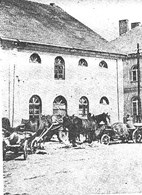 Click
below to view the pages for each family Click
below to view the pages for each family |
 Display/Hide All
Display/Hide All
 Chaiken
Family of Nezhin Chaiken
Family of Nezhin
 Chazanov
Family of Nezhin Chazanov
Family of Nezhin
 Fine
Family of Bialystok Fine
Family of Bialystok
 Geffen
Family of Vilkomir Geffen
Family of Vilkomir
 Goldberg
Family of Jablonka Goldberg
Family of Jablonka
 Katz/Hollander
Family Katz/Hollander
Family
 Zavelsky
Family of Glukhov Zavelsky
Family of Glukhov
| Click
here to see diary excerpts from our visit to Ciechanoviec. |


Click
here to read about the Dennison/Kaplan Families
 Click
here to read about the Schnitzler Family Click
here to read about the Schnitzler Family |
 |
| Excerpted from the Ciechanoviec
(Bialystok District) Memorial and Records, published by the
Ciechanovitzer Immigrants Association - in Israel and the USA |
Ancestral Home of the
Kaplan and Schnitzler Families
Ciechanoviec is located 69 k SW of Bialystok.
It was founded in the fifteenth century by the Kyski family,
whose descendants called themselves Ciechanowites. The oldest
synagogue in the town was built in the 15th century. Next to
the synagogue stood six Houses of Study; three built from wood
and three from stone.
In 1653 following the passing of the last of
the Kyski family the lands of Ciechanoviec passed into the possession
of the Radziwill family. The River Nurec divides the town into
two unequal parts:
The Old City: Belonged to the Bialystok Government District
from 1794 to 1843. From 1843 it was attached to the Bielsk district
of Grodno Province in Russia.
The New City: Was in Bialystok district from 1794 -1807 when
it was attached to Lomza District in Poland. The river served
as a frontier between Russia and Poland before the final partition
of Poland in 1795. In accordance with the decision of the Congress
of Vienna in 1814, almost the whole area was annexed by Russia
as the "Kingdom of Poland".
In 1775 there were 293 houses in the hamlet.
In 1795 there were 340 houses in Ciechanoviec
and the population numbered 2650 persons. In 1847 it had a Jewish
population of 2,054 and according to the census of 1897 the
total population was 5,569 of whom 3,743 were Jews. Although
we have no information about the persecution of the local Jews
by the non Jewish population, there are documents proving that
they paid heavy taxes to the estate owner, which did not accord
with their number. Jewish trade and commerce were shackled and
restricted by the local guilds. Heavy duties were placed on
everything even for the upkeep of the Mikvah.
Ciechanoviec was famous in Jewish history for it’s great
scholars who disseminated their wisdom and ethical views from
there, serving as Rabbis and preachers to the community. It
was a center of Torah study and also a center of manufacturing,
handicrafts and commerce. In the 19th century it had its trade
guilds of bakers, furriers, tailors, filmmakers, carpenters,
potters, locksmiths and shoemakers. It also had its associations
of textile workers and workers in breweries and spirit factories.
At the close of the nineteenth century, the economic situation
of the middle-class Jews was very unsatisfactory. They were
subject to the whims and caprices of the regional squires, who
did not show great affection for the Jews.
During W.W.I, most of Ciechanoviec was burned to the ground.
Many of the Jews living there fled elsewhere, seeking a refuge
in the depths of Russia. Only a handful of the 4,000 Jews who
had previously made up the community were left. However, when
the war was over, the Jews returned to their ruined homes and
rebuilt them.
In 1921, there were 1,649 Jews living there
out of a total population of 3,291. The Jewish community expanded
with remarkable rapidity. Its numbers doubled and tripled. Jewish
self security increased and there was a general feeling that
things would always be in order. When Ciechanoviec had reached
it's height, there were about 6,000 Jews living there, then,
everything was destroyed and swept away in the overwhelming
flood.
The Ciechanoviec Jews were entirely wiped out during the Holocaust.
Today there are no longer any Jews in the town. |
|
|
 |
| #1...The River
Nurec which divides the town into two unequal parts |
 |
| #2...The
Synagogue in the 1800s |
 |
| #3...The
Synagogue in 1995 slowly being restored. Today there is no working
synagogue as there are no Jewish families. |
 |
| #4...The
River Nurec which divides the two parts of Ciechanoviec, 1995. |
 |
| #5...The
Market Square in old Ciechanoviec |
 |
| #6...Ciechanoviec
has an open air museum with 15 old Jewish tombstones set in the ground
as a memorial along with replicas of old houses from 1850-1890. |

| Click here to see additional Ciechanoviec
pictures, |
|







